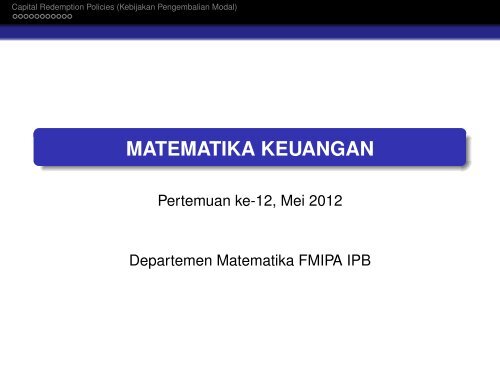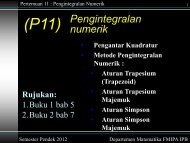MATEMATIKA KEUANGAN - Matematika IPB
MATEMATIKA KEUANGAN - Matematika IPB
MATEMATIKA KEUANGAN - Matematika IPB
Create successful ePaper yourself
Turn your PDF publications into a flip-book with our unique Google optimized e-Paper software.
Capital Redemption Policies (Kebijakan Pengembalian Modal)<br />
<strong>MATEMATIKA</strong> <strong>KEUANGAN</strong><br />
Pertemuan ke-12, Mei 2012<br />
Departemen <strong>Matematika</strong> FMIPA <strong>IPB</strong>
Capital Redemption Policies (Kebijakan Pengembalian Modal)<br />
Introduction and Premium Calculation<br />
Capital Redemption Policy<br />
A capital redemption policy is a contract which, in return for<br />
a single payment or a series of payments of stated<br />
amount, provides a specified sum of money at the end of a<br />
fixed period.<br />
The payment made by the policyholder are known as<br />
premium and the sum payable at the end of the fixed<br />
period is called the sum asured.<br />
The date on which the sum assured is payable is called the<br />
maturity date.
Capital Redemption Policies (Kebijakan Pengembalian Modal)<br />
Introduction and Premium Calculation<br />
Capital Redemption Policy<br />
The premiums paid by the policyholder are invested by the<br />
insurance company to produce the sum assured at the<br />
maturity date.<br />
In calculating the premiuns to be charged, the company<br />
must make:<br />
1 appropriate assumptions about the rate (or rates) of interest<br />
(net of tax) at which it will be able to invest the premiums<br />
received over the duration of the policy and<br />
2 due allowance for the expences which it expects to incur in<br />
relation to the policy.
Capital Redemption Policies (Kebijakan Pengembalian Modal)<br />
Introduction and Premium Calculation<br />
Capital Redemption Policy<br />
The essential requirement is that at the maturity date the<br />
accumulated amount of the premiums received, less any<br />
expenses incurred, should suffice to pay the sum assured.<br />
An explicit profit margin may also be required, but it is<br />
more usual for the issuing office to charge implicit profit<br />
margins, by making rather conservative assumptions about<br />
interest and expenses. If there is no explicit profit margin,<br />
the equation of value for the policy is:<br />
P = B + E<br />
where<br />
P = Value of premiums to be received by the company.<br />
B = Value of benefits payable by the company.<br />
E = Value of expenses associated with the policy, incurred<br />
by the company.
Capital Redemption Policies (Kebijakan Pengembalian Modal)<br />
Introduction and Premium Calculation<br />
Example<br />
Example 6.1.1<br />
A capital redemption policy with sum assured £10 000 and term<br />
15 years has level annual premiums, payable in advance<br />
throughout the duration of the policy. The company issuing the<br />
policy calculated the annual premium on the basis of an interest<br />
rate of 8% per annum with allowance for<br />
(a) initial expenses of £100 plus 10% of the first annual<br />
premium and<br />
(b) renewal expences of 4% of the second and each<br />
subsequent annual premium.<br />
Find the annual premium for the policy.
Capital Redemption Policies (Kebijakan Pengembalian Modal)<br />
Introduction and Premium Calculation<br />
Solution 6.1.1<br />
Let P ′ be the annual premium. After meeting its expences the<br />
company invests (0.9P ′ − 100) from the first premium and<br />
0.96P ′ from each subsequent premium. Thus, to provide the<br />
sum assured at the end of 15 years, we must have<br />
(0.9P ′ − 100)(1 + i) 15 14<br />
+ 0.96P ′ (1 + i) 15−t = 10000 at i = 8%.<br />
t=1<br />
This equation may be expressed in terms of standard functions<br />
in several ways. For example, we may write
Capital Redemption Policies (Kebijakan Pengembalian Modal)<br />
Introduction and Premium Calculation<br />
Solution 6.1.1<br />
0.9P ′ (1 + i) 15 + 0.96P ′ ¨s 14| = 10000 + 100(1 + i) 15<br />
0.9P ′ ¨s 15| + 0.06P ′ ¨s 14| = 10000 + 100(1 + i) 15<br />
0.96P ′ ¨s 15| − 0.06P ′ (1 + i) 15 = 10000 + 100(1 + i) 15<br />
0.96P ′ (s 16| − 1) − 0.06P ′ (1 + i) 15 = 10000 + 100(1 + i) 15<br />
P ′ (0.96(s 16| − 1) − 0.06(1 + i) 15 ) = 10000 + 100(1 + i) 15<br />
From the above equations we obtain the premium as<br />
P ′ =<br />
10000 + 100(1 + i) 15<br />
at i = 8%<br />
0.96(s16| − 1) − 0.06(1 + i) 15<br />
= $368.99
Capital Redemption Policies (Kebijakan Pengembalian Modal)<br />
Introduction and Premium Calculation<br />
Example<br />
Example 6.1.2<br />
Consider the capital redemption policy described in the<br />
previous example. Suppose, however, that, in order to allow for<br />
an increases in expenses over the duration of the policy, the<br />
company calculated the annual premium on the basis of the<br />
same interest rate and initial expenses as above but allowed for<br />
renewal expenses (associated with the second and each<br />
subsequent premium) of<br />
(a) £5 plus<br />
(b) an increasing percentage of each premium-the amount<br />
increasing linearly from 2.5% of the second premium to 5%<br />
of the final premium.<br />
Find the annual premium.
Capital Redemption Policies (Kebijakan Pengembalian Modal)<br />
Introduction and Premium Calculation<br />
Solution 6.1.2<br />
For t = 1, 2, . . . , 14, let λt denote the increasing percentage of<br />
the premium due at time t which is adsorbed by expenses.<br />
Then<br />
λt − 2.5 =<br />
5 − 2.5<br />
(t − 1)<br />
14 − 1<br />
λt = 2.3077 + 0.1923t.<br />
Let P ′ be the annual premium. The equation of value for the<br />
policy may expressed as<br />
(0.9P ′ − 100)(1 + i) 15 +<br />
14<br />
t=1<br />
<br />
P ′ − 5 −<br />
2.3077 + 0.1923t<br />
P<br />
100<br />
′<br />
<br />
(1 + i) 15−t = 10000.
Capital Redemption Policies (Kebijakan Pengembalian Modal)<br />
Introduction and Premium Calculation<br />
Solution 6.1.2<br />
Thus<br />
(0.9P ′ (1 + i) 15 + 0.976923P ′ ¨s 14| − 0.001923P ′<br />
14<br />
= 10000 + 5¨s 14| + 100(1 + i) 15 .<br />
The summation on the left-hand side of the last equation is<br />
simply (I¨s) 14| , which equals<br />
¨s 14| − 14<br />
d<br />
t=1<br />
t(1 + i) 15−t
Capital Redemption Policies (Kebijakan Pengembalian Modal)<br />
Introduction and Premium Calculation<br />
Solution 6.1.2<br />
Hence the equation for P ′ is<br />
P ′<br />
<br />
0.9(1 + i) 15 <br />
¨s 14| − 14<br />
+ 0.976923¨s 14| − 0.001923<br />
d<br />
= 10000 + 5¨s 14| + 100(1 + i) 15 at i = 8%.<br />
Finally we obtain<br />
P ′ = 10447.977/28.0881 = $371.97<br />
This premium is slightly greater than that found in example<br />
6.1.1. The renewal expenses increase from £14.30 to £23.60,<br />
in comparison with the level renewal expenses of £14.76 for the<br />
first example.




